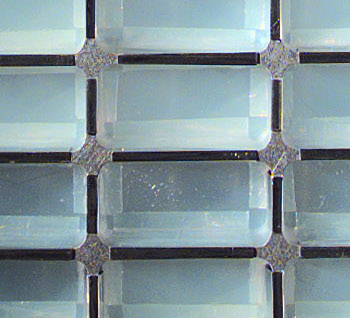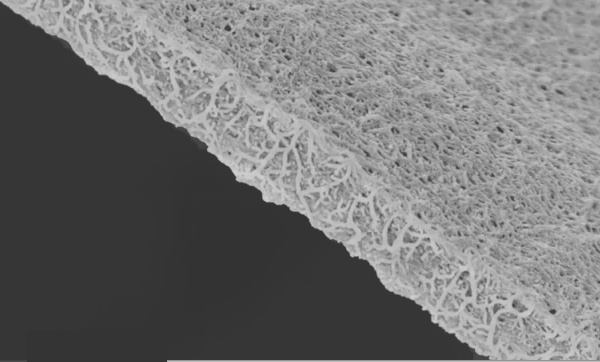
Carbon Nano-Aerogel
March 14, 2011 A research article on carbon nanotube aerogels was published with little fanfare in ACS Nano in December, 2010.[1] This article has recently gotten some attention in Internet postings, since it's been linked to possible medical and energy applications.[2-4] Love may make the world go 'round, science may explain why the world goes around, but applications of science are nice to have around. There are certainly more cellphones and iPods than periodic tables in students' book bags. The article, by an interdisciplinary team of chemists, materials scientists and physicists at the University of Central Florida (Orlando, Florida), describes a method for making aerogels with multiwalled carbon nanotubes (MWCNTs). I briefly described aerogels in a previous article (Gel Filtration, August 02, 2007). A regular gel, as in last night's gelatin dessert, is a colloid of interconnected particles "floating" in a liquid medium. In the case of the gelatin dessert, these are protein molecules in water. Gels are interesting, since they have a density close to that of their liquid, but mechanical properties like solids. Aerogels are gels in which the liquid has been replaced by a gas, making them extremely lightweight. The most common use for such materials is as thermal insulators, and their lightness makes them suitable for many aerospace applications. They helped to insulate the Mars Rovers. Aerogels were used as a capture medium for interplanetary dust in the NASA Stardust spacecraft. The aerogel detector, a portion of which is shown in the photograph, was made from ninety blocks of silica aerogel with 99.8% empty space and 0.01% the density of silica glass. | (NASA Image) |
 Photomicrograph of a multiwalled carbon nanotube aerogel. The scale of the image is a few micrometers across (UCF photograph).
As shown in the above photomicrograph, the nanotubes with 100 nm walls were separated by voids that were about 50-150 μm in size. The surface area was measured as 580 m2/g. The MWCNT aerogels were able to withstand many mechanical compression cycles, and they had an electrical conductivity of 3.2 x 10-2 S·cm-1. It was found that an electrical current pulse would increase the conductivity to 0.67 S·cm-1.
The material could be reversibly compressed to just 5% of its volume, for at least a thousand cycles.[2] Most significantly, the conductivity was highly sensitive to pressure,[2] much like the carbon button microphones I wrote about earlier (Piezomolecular Effect, February 22, 2011). The large surface area, combined with its intrinsic conductivity, indicates a possible use as a chemical sensor.[3] Since this material is essentially rarefied carbon, it's been suggested that the name, "frozen smoke," may be most appropriate.[4]
Photomicrograph of a multiwalled carbon nanotube aerogel. The scale of the image is a few micrometers across (UCF photograph).
As shown in the above photomicrograph, the nanotubes with 100 nm walls were separated by voids that were about 50-150 μm in size. The surface area was measured as 580 m2/g. The MWCNT aerogels were able to withstand many mechanical compression cycles, and they had an electrical conductivity of 3.2 x 10-2 S·cm-1. It was found that an electrical current pulse would increase the conductivity to 0.67 S·cm-1.
The material could be reversibly compressed to just 5% of its volume, for at least a thousand cycles.[2] Most significantly, the conductivity was highly sensitive to pressure,[2] much like the carbon button microphones I wrote about earlier (Piezomolecular Effect, February 22, 2011). The large surface area, combined with its intrinsic conductivity, indicates a possible use as a chemical sensor.[3] Since this material is essentially rarefied carbon, it's been suggested that the name, "frozen smoke," may be most appropriate.[4]
References:
- Jianhua Zou†, Jianhua Liu, Ajay Singh Karakoti, Amit Kumar, Daeha Joung, Qiang Li, Saiful I. Khondaker, Sudipta Seal and Lei Zhai, "Ultralight Multiwalled Carbon Nanotube Aerogel," ACS Nano, vol. 4, no. 12 (December 28, 2010), pp. 7293-7302.
- Stewart Bland, "Solid smoke," Materials Today, March 1, 2011
- Zenaida Gonzalez, "New 'Frozen Smoke' May Improve Robotic Surgery," University of Central Florida Press Release, March 1, 2011
- Timon Singh, "Super Batteries Made From ‘Frozen Smoke’ May be Here Soon," Inhabitat.com, March 2, 2011
- Stewart Bland, "Solid smoke," Materials Today, March 1, 2011